Abstract
A total of 144 studies were analysed to examine the impact of improved water supply and sanitation facilities on ascariasis, diarrhoea, dracunculiasis, hookworm infection, schistosomiasis, and trachoma. These diseases were selected because they are widespread and illustrate the variety of mechanisms through which improved water and sanitation can protect people. Disease-specific median reduction levels were calculated for all studies, and separately for the more methodologically rigorous ones. For the latter studies, the median reduction in morbidity for diarrhoea, trachoma, and ascariasis induced by water supplies and/or sanitation was 26%, 27%, and 29%, respectively; the median reduction for schistosomiasis and dracunculiasis was higher, at 77% and 78%, respectively. All studies of hookworm infection were flawed apart from one, which reported a 4% reduction in incidence. For hookworm infection, ascariasis, and schistosomiasis, the reduction in disease severity, as measured in egg counts, was greater than that in incidence or prevalence. Child mortality fell by 55%, which suggests that water and sanitation have a substantial impact on child survival. Water for personal and domestic hygiene was important in reducing the rates of ascariasis, diarrhoea, schistosomiasis, and trachoma. Sanitation facilities decreased diarrhoea morbidity and mortality and the severity of hookworm infection. Better water quality reduced the incidence of dracunculiasis, but its role in diarrhoeal disease control was less important than that of sanitation and hygiene.
Full text
PDF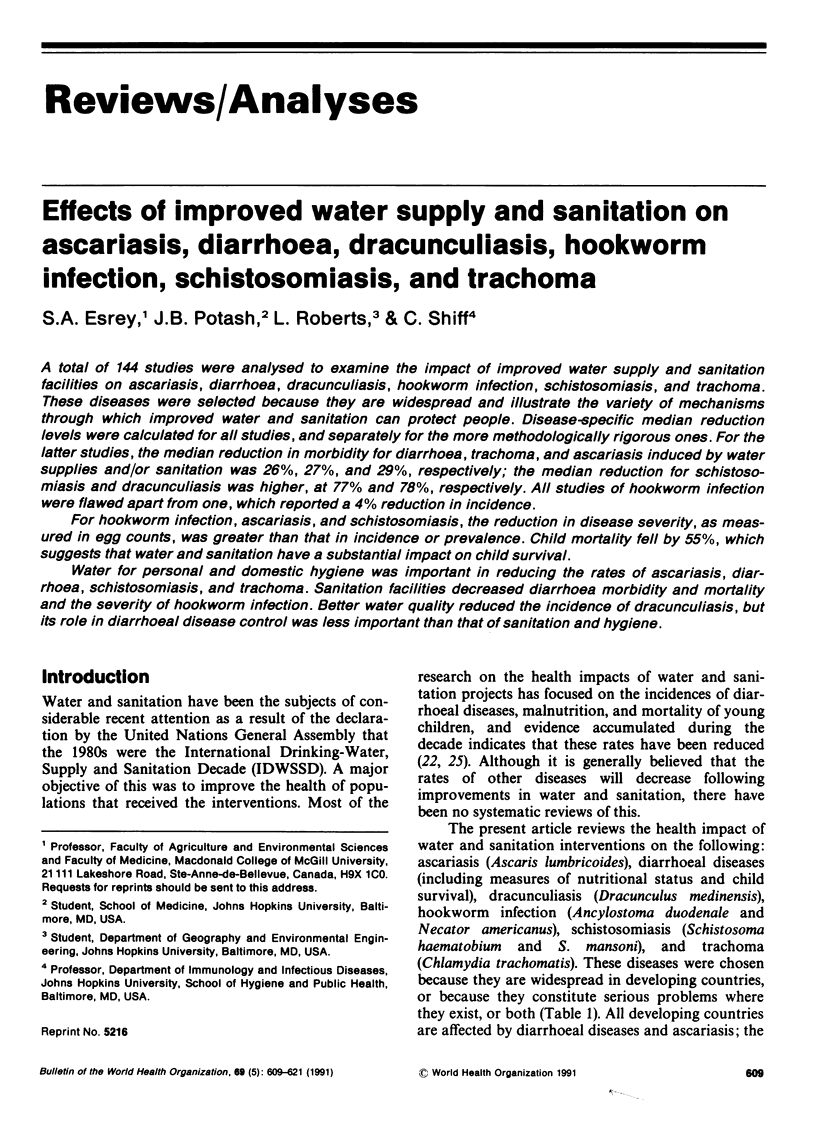



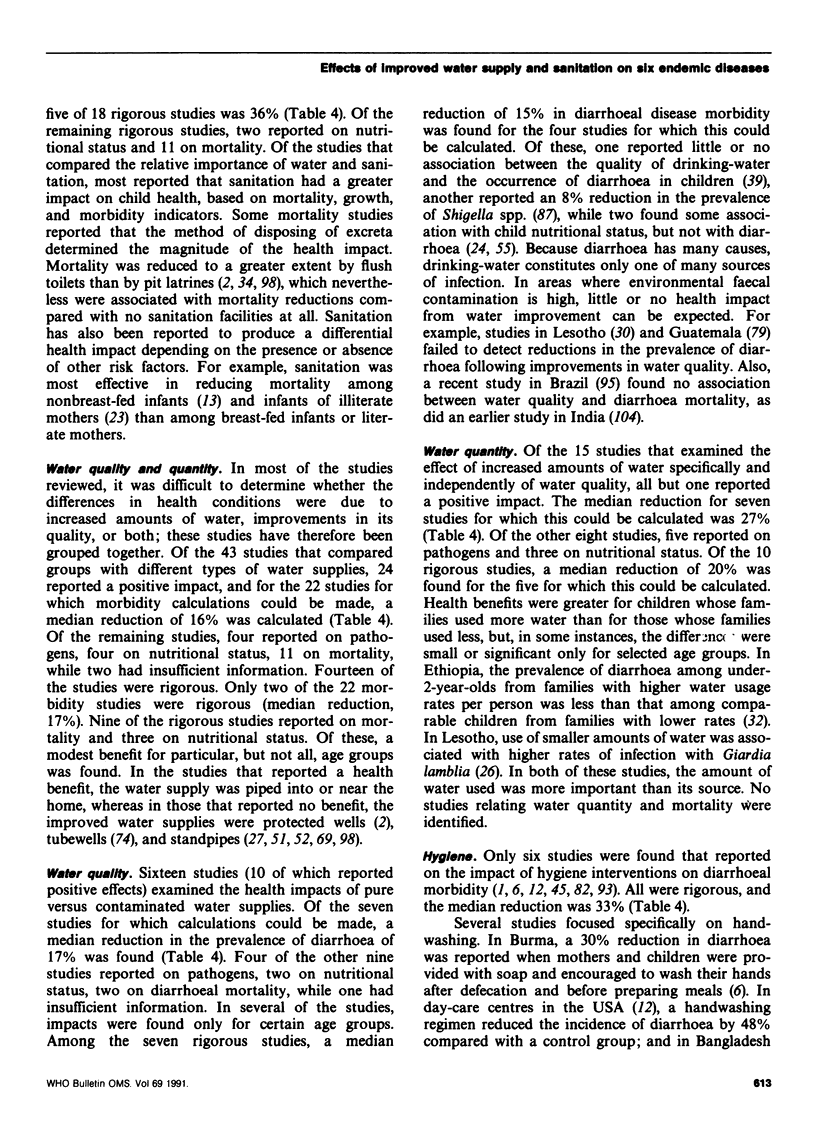
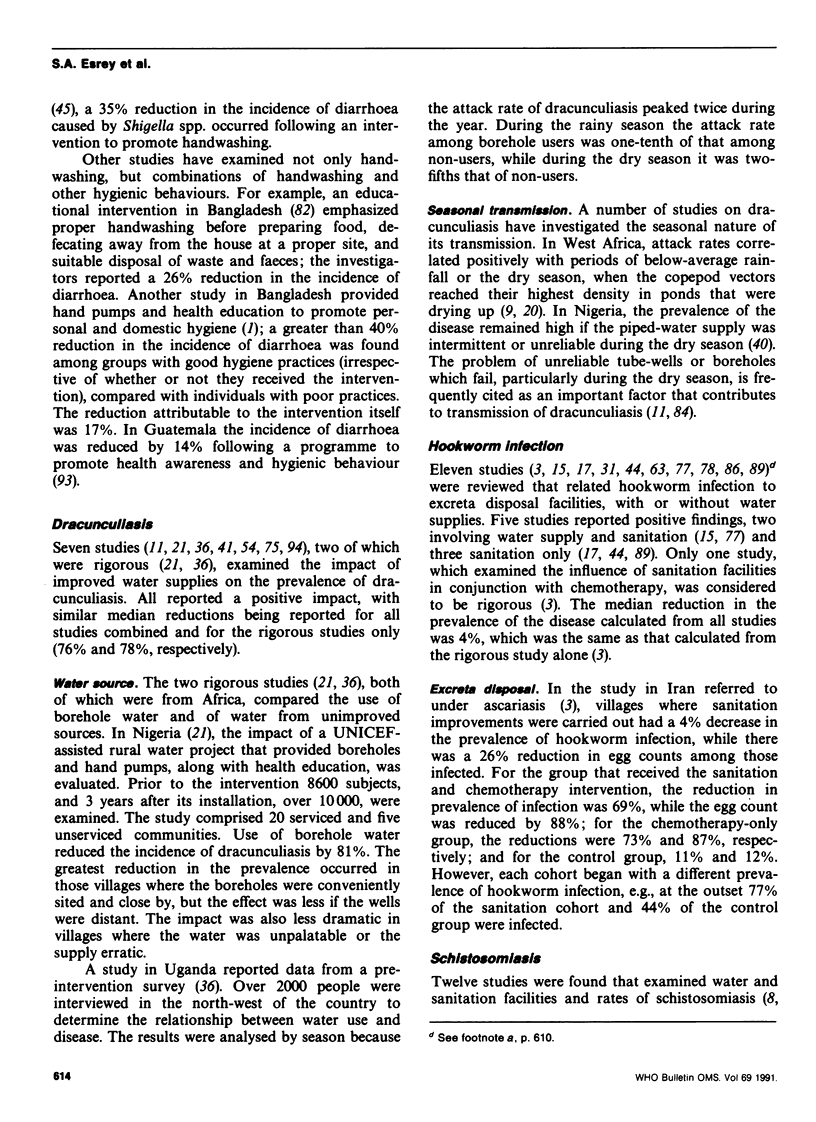
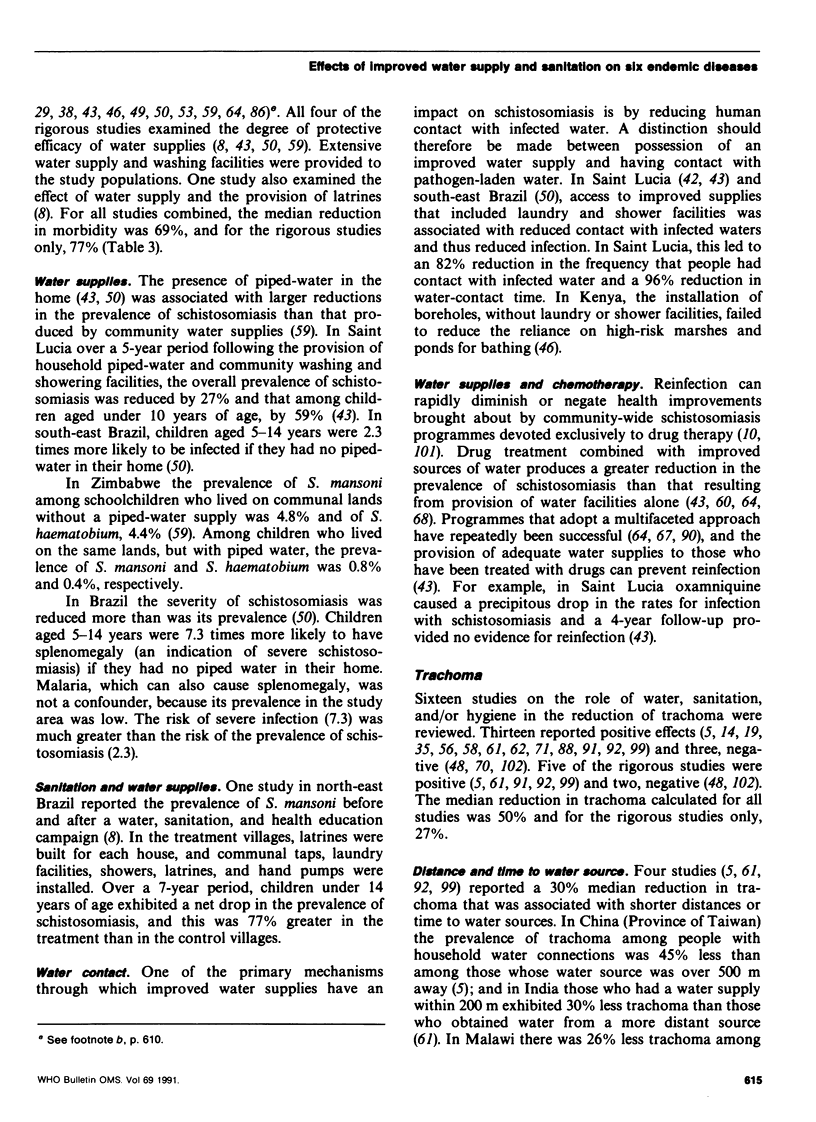


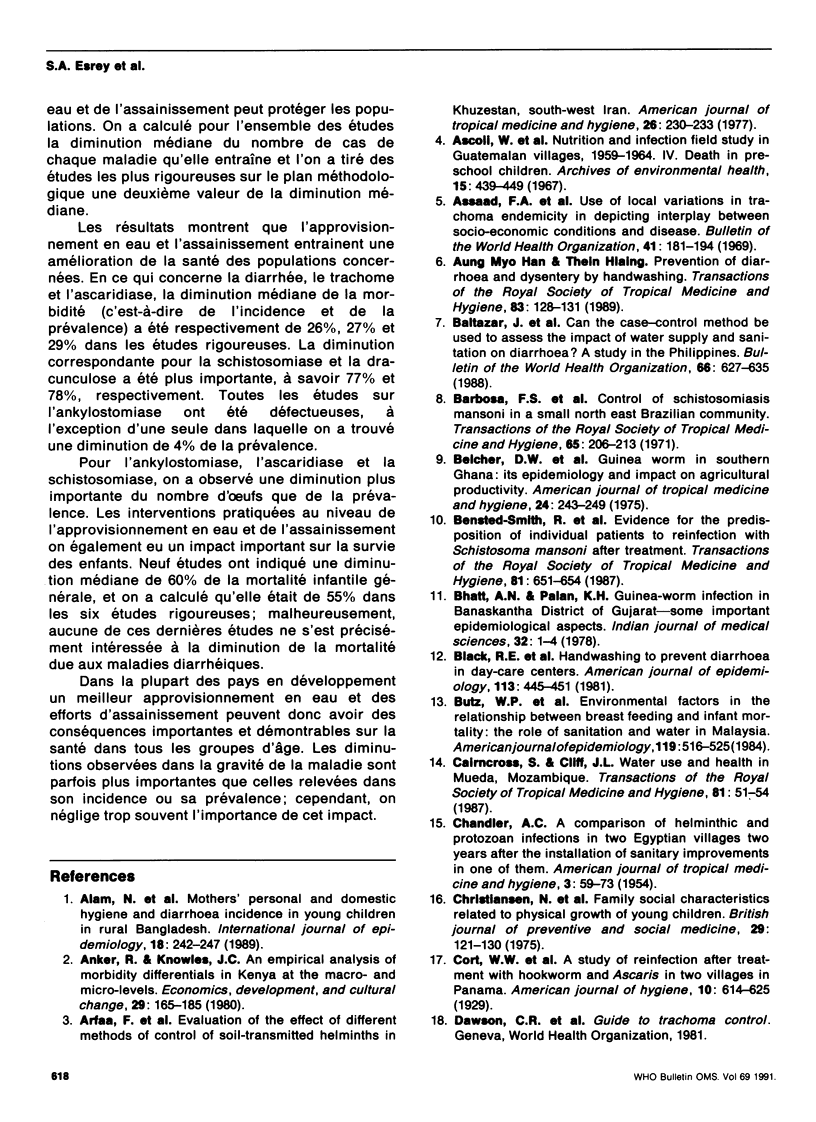
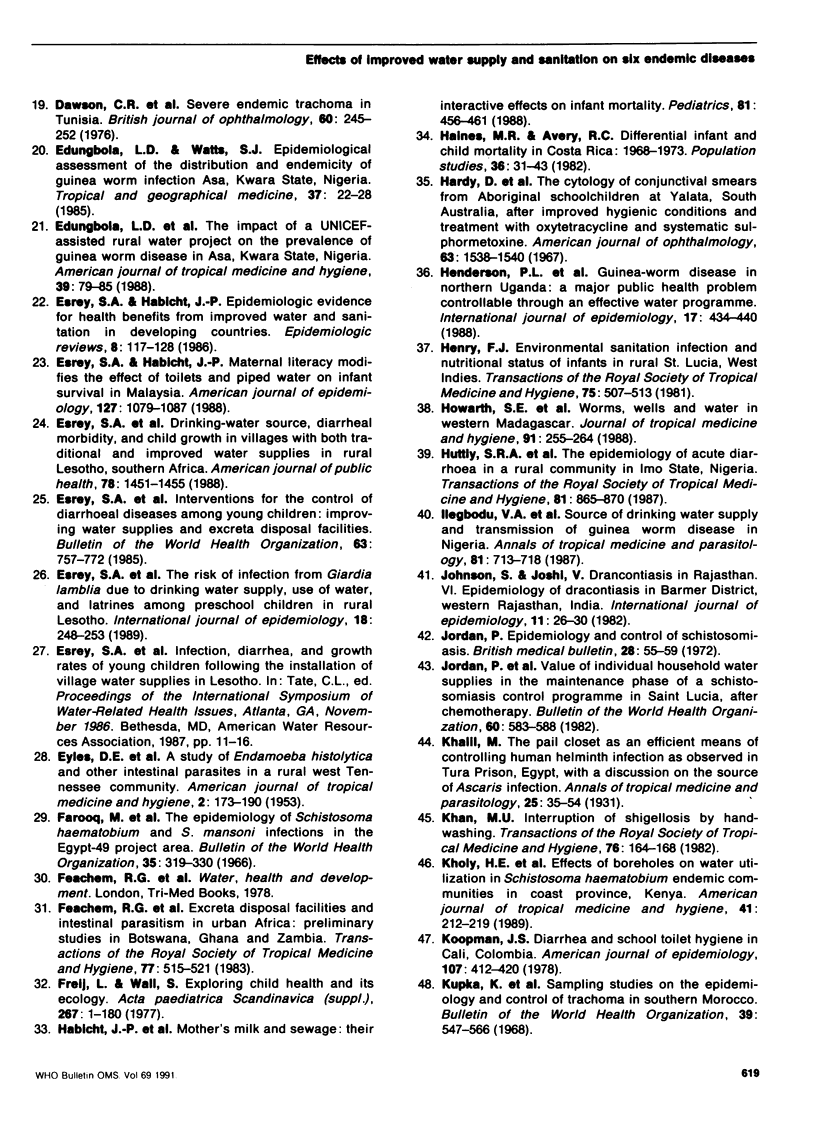


Selected References
These references are in PubMed. This may not be the complete list of references from this article.
- Alam N., Wojtyniak B., Henry F. J., Rahaman M. M. Mothers' personal and domestic hygiene and diarrhoea incidence in young children in rural Bangladesh. Int J Epidemiol. 1989 Mar;18(1):242–247. doi: 10.1093/ije/18.1.242. [DOI] [PubMed] [Google Scholar]
- Arfaa F., Sahba G. H., Farahmandian I., Jalali H. Evaluation of the effect of different methods of control of soil-transmitted helminths in Khuzestan, southwest Iran. Am J Trop Med Hyg. 1977 Mar;26(2):230–233. doi: 10.4269/ajtmh.1977.26.230. [DOI] [PubMed] [Google Scholar]
- Baltazar J., Briscoe J., Mesola V., Moe C., Solon F., Vanderslice J., Young B. Can the case-control method be used to assess the impact of water supply and sanitation on diarrhoea? A study in the Philippines. Bull World Health Organ. 1988;66(5):627–635. [PMC free article] [PubMed] [Google Scholar]
- Barbosa F. S., Pinto R., Souza O. A. Control of schistosomiasis mansoni in a small north east Brazilian community. Trans R Soc Trop Med Hyg. 1971;65(2):206–213. doi: 10.1016/0035-9203(71)90220-3. [DOI] [PubMed] [Google Scholar]
- Belcher D. W., Wurapa F. K., Ward W. B., Lourie I. M. Guinea worm in southern Ghana: its epidemiology and impact on agricultural productivity. Am J Trop Med Hyg. 1975 Mar;24(2):243–249. doi: 10.4269/ajtmh.1975.24.243. [DOI] [PubMed] [Google Scholar]
- Bensted-Smith R., Anderson R. M., Butterworth A. E., Dalton P. R., Kariuki H. C., Koech D., Mugambi M., Ouma J. H., arap Siongok T. K., Sturrock R. F. Evidence for predisposition of individual patients to reinfection with Schistosoma mansoni after treatment. Trans R Soc Trop Med Hyg. 1987;81(4):651–654. doi: 10.1016/0035-9203(87)90442-1. [DOI] [PubMed] [Google Scholar]
- Butz W. P., Habicht J. P., DaVanzo J. Environmental factors in the relationship between breastfeeding and infant mortality: the role of sanitation and water in Malaysia. Am J Epidemiol. 1984 Apr;119(4):516–525. doi: 10.1093/oxfordjournals.aje.a113769. [DOI] [PubMed] [Google Scholar]
- CHANDLER A. C. A comparison of helminthic and protozoan infections in two Egyptian villages two years after the installation of sanitary improvements in one of them. Am J Trop Med Hyg. 1954 Jan;3(1):59–73. doi: 10.4269/ajtmh.1954.3.59. [DOI] [PubMed] [Google Scholar]
- Cairncross S., Cliff J. L. Water use and health in Mueda, Mozambique. Trans R Soc Trop Med Hyg. 1987;81(1):51–54. doi: 10.1016/0035-9203(87)90280-x. [DOI] [PubMed] [Google Scholar]
- Dawson C. R., Daghfous T., Messadi M., Hoshiwara I., Schachter J. Severe endemic trachoma in Tunisia. Br J Ophthalmol. 1976 Apr;60(4):245–252. doi: 10.1136/bjo.60.4.245. [DOI] [PMC free article] [PubMed] [Google Scholar]
- EYLES D. E., JONES F. E., SMITH C. S. A study of Endamoeba histolytica and other intestinal parasites in a rural West Tennessee community. Am J Trop Med Hyg. 1953 Mar;2(2):173–190. doi: 10.4269/ajtmh.1953.2.173. [DOI] [PubMed] [Google Scholar]
- Edungbola L. D., Watts S. J., Alabi T. O., Bello A. B. The impact of a UNICEF-assisted rural water project on the prevalence of guinea worm disease in Asa, Kwara State, Nigeria. Am J Trop Med Hyg. 1988 Jul;39(1):79–85. doi: 10.4269/ajtmh.1988.39.79. [DOI] [PubMed] [Google Scholar]
- Edungbola L. D., Watts S. J. Epidemiological assessment of the distribution and endemicity of guinea worm infection in Asa, Kwara State, Nigeria. Trop Geogr Med. 1985 Mar;37(1):22–28. [PubMed] [Google Scholar]
- Esrey S. A., Collett J., Miliotis M. D., Koornhof H. J., Makhale P. The risk of infection from Giardia lamblia due to drinking water supply, use of water, and latrines among preschool children in rural Lesotho. Int J Epidemiol. 1989 Mar;18(1):248–253. doi: 10.1093/ije/18.1.248. [DOI] [PubMed] [Google Scholar]
- Esrey S. A., Feachem R. G., Hughes J. M. Interventions for the control of diarrhoeal diseases among young children: improving water supplies and excreta disposal facilities. Bull World Health Organ. 1985;63(4):757–772. [PMC free article] [PubMed] [Google Scholar]
- Esrey S. A., Habicht J. P. Epidemiologic evidence for health benefits from improved water and sanitation in developing countries. Epidemiol Rev. 1986;8:117–128. doi: 10.1093/oxfordjournals.epirev.a036290. [DOI] [PubMed] [Google Scholar]
- Esrey S. A., Habicht J. P., Latham M. C., Sisler D. G., Casella G. Drinking water source, diarrheal morbidity, and child growth in villages with both traditional and improved water supplies in rural Lesotho, southern Africa. Am J Public Health. 1988 Nov;78(11):1451–1455. doi: 10.2105/ajph.78.11.1451. [DOI] [PMC free article] [PubMed] [Google Scholar]
- Esrey S. A., Habicht J. P. Maternal literacy modifies the effect of toilets and piped water on infant survival in Malaysia. Am J Epidemiol. 1988 May;127(5):1079–1087. doi: 10.1093/oxfordjournals.aje.a114884. [DOI] [PubMed] [Google Scholar]
- Farooq M., Nielsen J., Samaan S. A., Mallah M. B., Allam A. A. The epidemiology of Schistosoma haematobium and S. mansoni infections in the Egypt-49 project area. 3. Prevalence of bilharziasis in relation to certain environmental factors. Bull World Health Organ. 1966;35(3):319–330. [PMC free article] [PubMed] [Google Scholar]
- Feachem R. G., Guy M. W., Harrison S., Iwugo K. O., Marshall T., Mbere N., Muller R., Wright A. M. Excreta disposal facilities and intestinal parasitism in urban Africa: preliminary studies in Botswana, Ghana and Zambia. Trans R Soc Trop Med Hyg. 1983;77(4):515–521. doi: 10.1016/0035-9203(83)90128-1. [DOI] [PubMed] [Google Scholar]
- Habicht J. P., DaVanzo J., Butz W. P. Mother's milk and sewage: their interactive effects on infant mortality. Pediatrics. 1988 Mar;81(3):456–461. [PubMed] [Google Scholar]
- Henderson P. L., Fontaine R. E., Kyeyune G. Guinea worm disease in Northern Uganda: a major public health problem controllable through an effective water programme. Int J Epidemiol. 1988 Jun;17(2):434–440. doi: 10.1093/ije/17.2.434. [DOI] [PubMed] [Google Scholar]
- Henry F. J. Environmental sanitation infection and nutritional status of infants in rural St. Lucia, West Indies. Trans R Soc Trop Med Hyg. 1981;75(4):507–513. doi: 10.1016/0035-9203(81)90187-5. [DOI] [PubMed] [Google Scholar]
- Howarth S. E., Wilson J. M., Ranaivoson E., Crook S. E., Denning A. M., Hutchings M. S. Worms, wells and water in western Madagascar. J Trop Med Hyg. 1988 Oct;91(5):255–264. [PubMed] [Google Scholar]
- Huttly S. R., Blum D., Kirkwood B. R., Emeh R. N., Feachem R. G. The epidemiology of acute diarrhoea in a rural community in Imo State, Nigeria. Trans R Soc Trop Med Hyg. 1987;81(5):865–870. doi: 10.1016/0035-9203(87)90055-1. [DOI] [PubMed] [Google Scholar]
- Johnson S., Joshi V. Dracontiasis in Rajasthan. VI. Epidemiology of dracontiasis in Barmer district, Western Rajasthan, India. Int J Epidemiol. 1982 Mar;11(1):26–30. doi: 10.1093/ije/11.1.26. [DOI] [PubMed] [Google Scholar]
- Jordan P. Epidemiology and control of schistosomiasis. Br Med Bull. 1972 Jan;28(1):55–59. doi: 10.1093/oxfordjournals.bmb.a070894. [DOI] [PubMed] [Google Scholar]
- Jordan P., Unrau G. O., Bartholomew R. K., Cook J. A., Grist E. Value of individual household water supplies in the maintenance phase of a schistosomiasis control programme in Saint-Lucia, after chemotherapy. Bull World Health Organ. 1982;60(4):583–588. [PMC free article] [PubMed] [Google Scholar]
- Koopman J. S. Diarrhea and school toilet hygiene in Cali, Colombia. Am J Epidemiol. 1978 May;107(5):412–420. doi: 10.1093/oxfordjournals.aje.a112559. [DOI] [PubMed] [Google Scholar]
- Kupka K., Nizetic B., Reinhards J. Sampling studies on the epidemiology and control of trachoma in southern Morocco. Bull World Health Organ. 1968;39(4):547–566. [PMC free article] [PubMed] [Google Scholar]
- Lima e Costa M. F., Magalhães M. H., Rocha R. S., Antunes C. M., Katz N. Water-contact patterns and socioeconomic variables in the epidemiology of schistosomiasis mansoni in an endemic area in Brazil. Bull World Health Organ. 1987;65(1):57–66. [PMC free article] [PubMed] [Google Scholar]
- Logan J. W. Schistosomiasis in Swaziland--a comparative study of three irrigated estates. J Helminthol. 1983 Sep;57(3):247–253. doi: 10.1017/s0022149x00009561. [DOI] [PubMed] [Google Scholar]
- Lyons G. R. Guineaworm infection in the Wa district of north-western Ghana. Bull World Health Organ. 1972;47(5):601–610. [PMC free article] [PubMed] [Google Scholar]
- Marshall C. L. The relationship between trachoma and piped water in a developing area. Arch Environ Health. 1968 Aug;17(2):215–220. doi: 10.1080/00039896.1968.10665216. [DOI] [PubMed] [Google Scholar]
- Mason P. R., Patterson B. A., Loewenson R. Piped water supply and intestinal parasitism in Zimbabwean schoolchildren. Trans R Soc Trop Med Hyg. 1986;80(1):88–93. doi: 10.1016/0035-9203(86)90204-x. [DOI] [PubMed] [Google Scholar]
- Mason P. R., Tswana S. A. Single-dose metrifonate for the treatment of Schistosoma haematobium infection in an endemic area of Zimbabwe. Am J Trop Med Hyg. 1984 Jul;33(4):599–601. doi: 10.4269/ajtmh.1984.33.599. [DOI] [PubMed] [Google Scholar]
- Mathur G. M., Sharma R. Influence of some socio-economic factors on the prevalence of trachoma. Indian J Med Sci. 1970 Jun;24(6):325–334. [PubMed] [Google Scholar]
- Moore H. A., De la Cruz E., Vargas-Mendez O. Diarrheal disease studies in Costa Rica. IV. The influence of sanitation upon the prevalence of intestinal infection and diarrheal disease. Am J Epidemiol. 1965 Sep;82(2):162–184. doi: 10.1093/oxfordjournals.aje.a120542. [DOI] [PubMed] [Google Scholar]
- Negrón-Aponte H., Jobin W. R. Schistosomiasis control in Puerto Rico: twenty-five years of operational experience. Am J Trop Med Hyg. 1979 May;28(3):515–525. doi: 10.4269/ajtmh.1979.28.515. [DOI] [PubMed] [Google Scholar]
- PRATT-JOHNSON J. A., WESSELS J. H. Investigation into the control of trachoma in Sekhukuniland. S Afr Med J. 1958 Feb 22;32(8):212–215. [PubMed] [Google Scholar]
- Pickering H., Hayes R. J., Ng'andu N., Smith P. G. Social and environmental factors associated with the risk of child mortality in a peri-urban community in The Gambia. Trans R Soc Trop Med Hyg. 1986;80(2):311–316. doi: 10.1016/0035-9203(86)90045-3. [DOI] [PubMed] [Google Scholar]
- Popkin B. M. Time allocation of the mother and child nutrition. Ecol Food Nutr. 1980;9(1):1–14. doi: 10.1080/03670244.1980.9990579. [DOI] [PubMed] [Google Scholar]
- Portney G. L., Hoshiwara I. Prevalence of trachoma among Southwestern American Indian tribe. Am J Ophthalmol. 1970 Nov;70(5):843–848. doi: 10.1016/0002-9394(70)90510-6. [DOI] [PubMed] [Google Scholar]
- Prost A., Négrel A. D. Water, trachoma and conjunctivitis. Bull World Health Organ. 1989;67(1):9–18. [PMC free article] [PubMed] [Google Scholar]
- Rahman M., Rahaman M. M., Wojtyniak B., Aziz K. M. Impact of environmental sanitation and crowding on infant mortality in rural Bangladesh. Lancet. 1985 Jul 6;2(8445):28–31. doi: 10.1016/s0140-6736(85)90068-6. [DOI] [PubMed] [Google Scholar]
- Reddy C. R., Narasaiah I. L., Parvathi G. Epidemiological studies on guinea-worm infection. Bull World Health Organ. 1969 Apr;40(4):521–529. [PMC free article] [PubMed] [Google Scholar]
- STEWART W. H., McCABE L. J., Jr, HEMPHILL E. C., DeCAPITO T. Diarrheal disease control studies; the relationship of certain environmental factors to the prevalence of Shigella infection. Am J Trop Med Hyg. 1955 Jul;4(4):718–724. [PubMed] [Google Scholar]
- Sahba G. H., Arfaa F. The effect of sanitation on ascariasis in an Iranian village. J Trop Med Hyg. 1967 Feb;70(2):37–39. [PubMed] [Google Scholar]
- Snyder J. D., Merson M. H. The magnitude of the global problem of acute diarrhoeal disease: a review of active surveillance data. Bull World Health Organ. 1982;60(4):605–613. [PMC free article] [PubMed] [Google Scholar]
- Stanton B. F., Clemens J. D. An educational intervention for altering water-sanitation behaviors to reduce childhood diarrhea in urban Bangladesh. II. A randomized trial to assess the impact of the intervention on hygienic behaviors and rates of diarrhea. Am J Epidemiol. 1987 Feb;125(2):292–301. doi: 10.1093/oxfordjournals.aje.a114529. [DOI] [PubMed] [Google Scholar]
- Stanton B. F., Clemens J. D., Khair T. Educational intervention for altering water-sanitation behavior to reduce childhood diarrhea in urban Bangladesh: impact on nutritional status. Am J Clin Nutr. 1988 Nov;48(5):1166–1172. doi: 10.1093/ajcn/48.5.1166. [DOI] [PubMed] [Google Scholar]
- Stanton B. F., Clemens J. D. Socioeconomic variables and rates of diarrhoeal disease in urban Bangladesh. Trans R Soc Trop Med Hyg. 1987;81(2):278–282. doi: 10.1016/0035-9203(87)90241-0. [DOI] [PubMed] [Google Scholar]
- Steib K., Mayer P. Epidemiology and vectors of Dracunculus medinensis in northwest Burkina Faso, West Africa. Ann Trop Med Parasitol. 1988 Apr;82(2):189–199. doi: 10.1080/00034983.1988.11812228. [DOI] [PubMed] [Google Scholar]
- Stephenson L. S., Crompton D. W., Latham M. C., Arnold S. E., Jansen A. A. Evaluation of a four year project to control Ascaris infection in children in two Kenyan villages. J Trop Pediatr. 1983 Jun;29(3):175–184. doi: 10.1093/tropej/29.3.175. [DOI] [PubMed] [Google Scholar]
- Sutter E. E., Ballard R. C. Community participation in the control of trachoma in Gazankulu. Soc Sci Med. 1983;17(22):1813–1817. doi: 10.1016/0277-9536(83)90397-0. [DOI] [PubMed] [Google Scholar]
- Taylor H. R., Velasco F. M., Sommer A. The ecology of trachoma: an epidemiological study in southern Mexico. Bull World Health Organ. 1985;63(3):559–567. [PMC free article] [PubMed] [Google Scholar]
- Victora C. G., Smith P. G., Vaughan J. P., Nobre L. C., Lombardi C., Teixeira A. M., Fuchs S. C., Moreira L. B., Gigante L. P., Barros F. C. Water supply, sanitation and housing in relation to the risk of infant mortality from diarrhoea. Int J Epidemiol. 1988 Sep;17(3):651–654. doi: 10.1093/ije/17.3.651. [DOI] [PubMed] [Google Scholar]
- Watts S. J. Dracunculiasis in Africa in 1986: its geographic extent, incidence, and at-risk population. Am J Trop Med Hyg. 1987 Jul;37(1):119–125. doi: 10.4269/ajtmh.1987.37.119. [DOI] [PubMed] [Google Scholar]
- West S., Lynch M., Turner V., Munoz B., Rapoza P., Mmbaga B. B., Taylor H. R. Water availability and trachoma. Bull World Health Organ. 1989;67(1):71–75. [PMC free article] [PubMed] [Google Scholar]
- Wilkins H. A., Blumenthal U. J., Hagan P., Hayes R. J., Tulloch S. Resistance to reinfection after treatment of urinary schistosomiasis. Trans R Soc Trop Med Hyg. 1987;81(1):29–35. doi: 10.1016/0035-9203(87)90273-2. [DOI] [PubMed] [Google Scholar]
- Young B., Briscoe J. A case-control study of the effect of environmental sanitation on diarrhoea morbidity in Malawi. J Epidemiol Community Health. 1988 Mar;42(1):83–88. doi: 10.1136/jech.42.1.83. [DOI] [PMC free article] [PubMed] [Google Scholar]
- ZAHEER M., PRASAD B. G., GOVIL K. K., BHADURYT A note on urban water supply in Uttar Pradesh. J Indian Med Assoc. 1962 Feb 16;38:177–182. [PubMed] [Google Scholar]
- de Lima e Costa M. F., Rocha R. S., de Almeida Magalhães M. H., Katz N. A clinico-epidemiological survey of schistosomiasis mansoni in a hyperendemic area in Minas Gerais State (Comercinho, Brazil). I. Differences in the manifestations of schistosomiasis in the town centre and in the environs. Trans R Soc Trop Med Hyg. 1985;79(4):539–545. doi: 10.1016/0035-9203(85)90090-2. [DOI] [PubMed] [Google Scholar]
- el Kholy H., Arap Siongok T. K., Koech D., Sturrock R. F., Houser H., King C. H., Mahmoud A. A. Effects of borehole wells on water utilization in Schistosoma haematobium endemic communities in Coast Province, Kenya. Am J Trop Med Hyg. 1989 Aug;41(2):212–219. doi: 10.4269/ajtmh.1989.41.212. [DOI] [PubMed] [Google Scholar]


